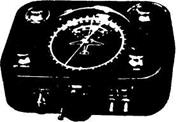OTHER NAVIGATIONAL AIDS
We have seen, in previous lessons, how VOR/DME/ILS work. However, we have not yet discussed DirectionFinding (1)which is one of the oldest methods of navigation. Direction finding originally was developed in the 1920s to provide a "fix" (2)on an aircraft’s position. Generally speaking, this is an emergency type of navigational device (3)which enables a controller to help a "lost" pilot find an airport by giving him headings to follow. The technique is useful on occasions in search and rescue operations to plot the location of an aircraft at an unknown position.
|
 Automaticdirectionfinding (ADF) is an airbornecounterpart (4, 5, 6)of the ground Direction Finding equipment. In an aircraft, the ADF permits a pilot to take continuous bearings automatically on any ground station operating on a frequency usable by the airborne equipment. The ground stations which are available to the pilot for this purpose include "compasslocators", Non-directionalRadioBeacon (7, 8)(NDB), and commercial radio-broadcasting stations. All of these may be used by the ADF-equipped aircraft for en-route navigation and for approaches to certain airports in remote areas. ADF is used mainly as a "backup" (9)navigational device, or in areas of the world where traffic is light and ground navigation aids are limited. It does not provide the position-fixing accuracy or display needed for modern air navigation in high-density (10)traffic patterns.
Automaticdirectionfinding (ADF) is an airbornecounterpart (4, 5, 6)of the ground Direction Finding equipment. In an aircraft, the ADF permits a pilot to take continuous bearings automatically on any ground station operating on a frequency usable by the airborne equipment. The ground stations which are available to the pilot for this purpose include "compasslocators", Non-directionalRadioBeacon (7, 8)(NDB), and commercial radio-broadcasting stations. All of these may be used by the ADF-equipped aircraft for en-route navigation and for approaches to certain airports in remote areas. ADF is used mainly as a "backup" (9)navigational device, or in areas of the world where traffic is light and ground navigation aids are limited. It does not provide the position-fixing accuracy or display needed for modern air navigation in high-density (10)traffic patterns.
There are other navigational aids: Decca and LORAN (11, 12)are two of the most commonly known in aviation.